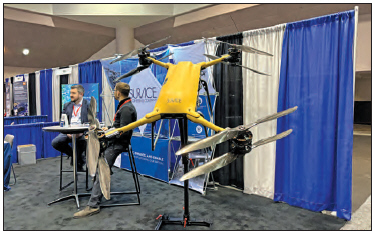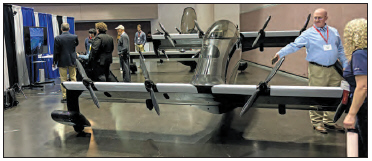Filed by Direct Selling Acquisition Corp.
Pursuant to Rule 425 of the Securities Act of 1933
and deemed filed pursuant to Rule 14a-12
of the Securities Exchange Act of 1934
Subject Company: Hunch Technologies Limited.
Commission File No. 132-02865
The following is a magazine article made available in April 2024.
| 24 | In Flight USA Celebrating 39 Years | April 2024 |
WILL VTOL BECOME THE NEXT BIG WAVE IN AVIATION?
|
By Annamarie Buonocore
In our efforts to deliver the most relevant news, In Flight USA pays attention to big trends that have the potential to alter the course of aviation as we know it. Over the years, we have looked at drones and other unmanned aircraft. Will these replace aviation as we know? We say, not so fast. But another branch of aviation that has the ability to bring a boom to private aviation as we know is the VTOL (vertical takeoff and landing) industry. Also known as air taxis, VTOL aircraft can transport people and cargo within a short time, taking off and landing in the middle of major cities or in rural areas. The VTOL industry will increase the number of pilot jobs, reduce land traffic congestion, improve the planet’s environmental quality, and will increase interest in aviation and all things that fly. |
A VTOL aircraft on display at the annual Vertical Takeoff Society Conference in San Jose, CA. (Annamarie Buonocore) |
you are using.
AD: We currently operate a model that is very similar to Blade U.S. We work with operators who commit the aircraft that they have for a number of hours every month. These are typically Airbus 125s and Bell 505s. These are five or six-seaters. The challenge in India is that there is a huge shortage of helicopter craft. In India, we only have 250 civil registered helicopters. There are limitations of what you can get from operators. That is why we have taken advantage of the government setting up a leasing unit in a special economic zone. Through this initiative, we would lease aircraft directly from Original Equipment Manufacturers (OEMs) to augment the fleet. | ||||
|
Earlier this month, I had the opportunity to attend the Vertical Flight Society’s conference in Santa Clara, Calif. This event was an intriguing three days of learning, networking, and exploring some pretty cool looking aircraft. See photos. At this event, I learned more about vertical flight and this California-based society that is dedicated to researching and promoting it. I met |
industry professionals and startup owners already vested in this sector of aviation. I also met professionals from other industries looking to break into this new booming market.
A couple days before attending this educational event, I had the opportunity to interview Amit Dutta, the Managing Director of Hunch Mobility, an air taxi company based in India. As one VTS conference attendee said, “If you think the traffic in the Bay Area or LA is bad, |
you should experience it in Bangladesh or Hong Kong.” Dutta understands this better than anyone and is focused on utilizing air taxis to improve traffic and environmental congestion in India. The following is the interview I did with him. We look forward to working with the VTOL market and watching it thrive and improve aviation as we know it.
In Flight USA: What trends are you following in India that prompted you to get into this business? |
IFUSA: Right, so the great thing about using helicopters and rotorcraft is that they don’t have to land on a runway, and they don’t have to land in an airport. So tell me about the stations where people are taking off and landing. Is it like a bus stop? Are you putting them in urban areas?
AD: That is a very good point. In India, there are very few airports, unlike in the U.S., where you have airports all over. India does not have that infrastructure. It takes nearly 10 years for an airport to get constructed. | |||
|
Amit Dutta: It’s no secret that India, with its current economic growth rate, has a huge problem with congestion. Congestion in India costs upwards of $22 billion per year. Just to give you a sense of in-road traffic, we have about 296 million vehicles on the road. Along with India’s economic growth comes traffic congestion that is going to get much worse. By car, it would take two hours to get from Bangalore to the city center. Bangalore is like the Silicon Valley of India. It has a lot of international visitors. We can do that journey via aircraft in 15 minutes. This epitomizes the pain point that we solve. We do several routes. One is Bombay to Pune. Pune is like our Detroit. There is a lot of automobile manufacturing there. Bombay of course is the financial capital. There is so much traffic there that it is a five-hour journey. We can make that flight in 45-50 minutes. So, what prompted us to take the step? This traffic congestion in India is across the country. It’s not like in the U.S. where the congestion is just on the coasts. With our economic progress and the fact that we are poised to become the third largest economy in the world, these problems will only worsen. Being the first mover to create this mobility platform, we saw it as a huge opportunity.
IFUSA: Tell me about the planes |
Let’s take the example of Pune. If you want to take a flight from there to Bombay, you would drive an hour and a half to the airport and spend another 45 minutes going through check-in or maybe more, and then of course, the waiting time. What we offer is a heliport. We take heliports on lease in the center of the prime residential area in Pune. We land in the heart of Bombay, in a place called Mahalaxmi, where we have taken a lease. The advantage that we offer customers is that we are landing right in the center of where they work. We also do routes where we go to well-known locations in different cities. We are able to land at hotel venues, which have created their own landing sites. That is the big advantage; you are not spending time commuting from an airport when you stay for a holiday; you are landing right in the center of where you need to be.
IFUSA: Yes, this is great, and it is a great business opportunity for landowners as well who want to lease their land.
AD: At Bangalore airport, you get out of the airport and then a limo picks you up in about eight minutes and brings you to the helipads, and from the helipads, you take off. The advantage we have is the rental rates for helipads in India are very affordable. At the Bangalore airport, we might pay around
Continued on Page 25 | |||||

